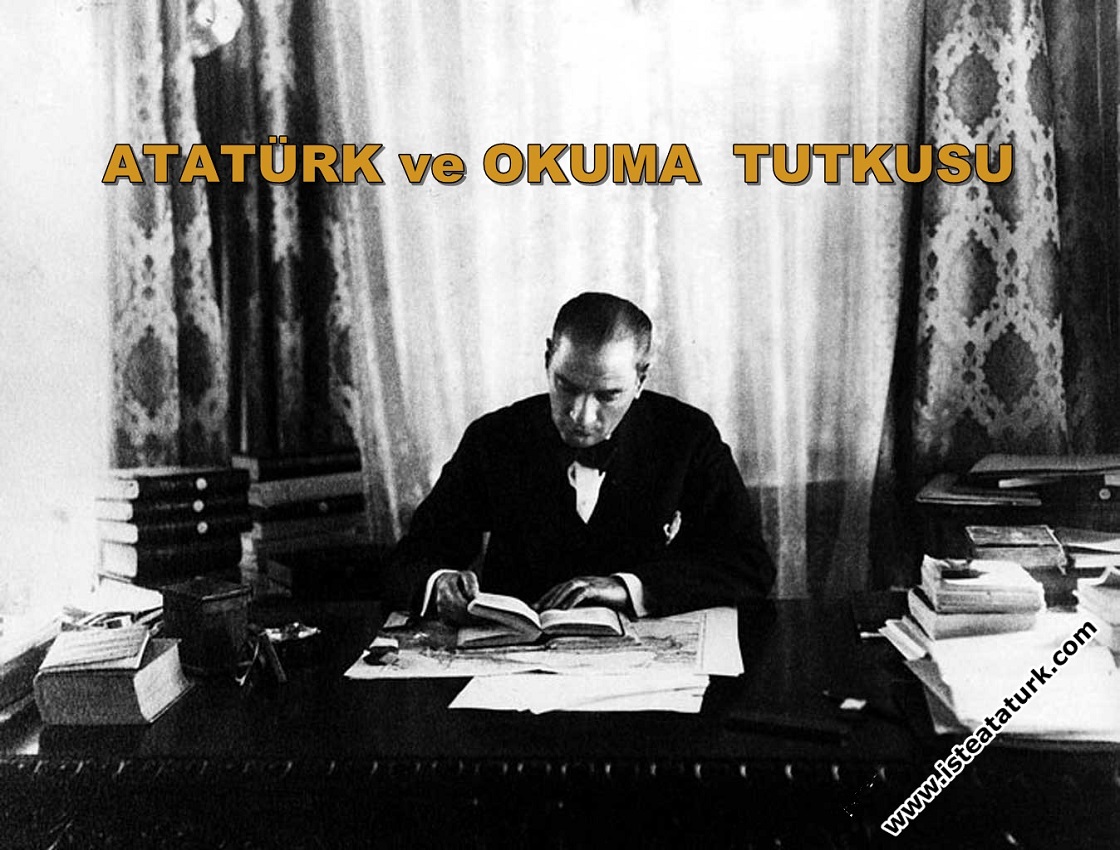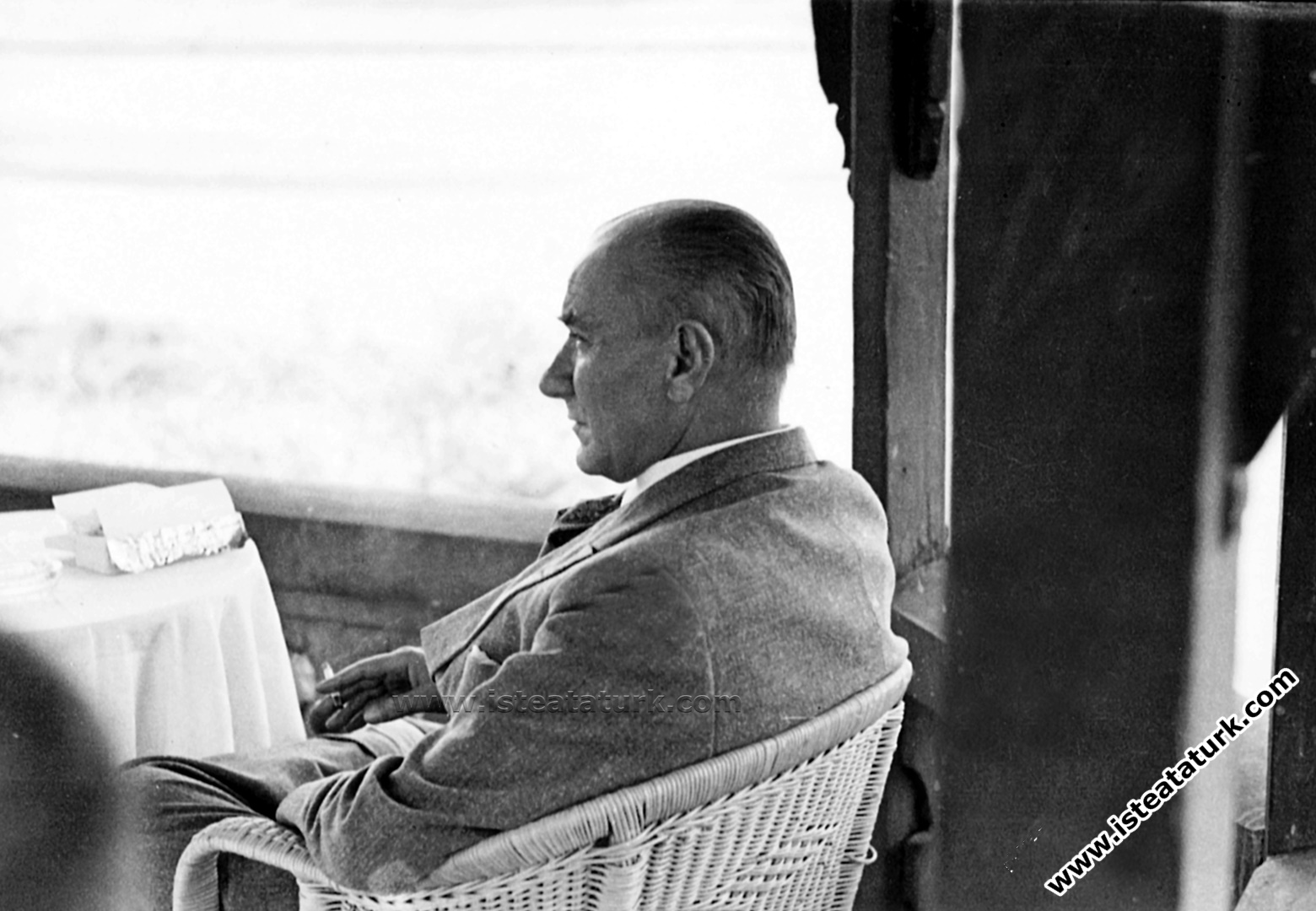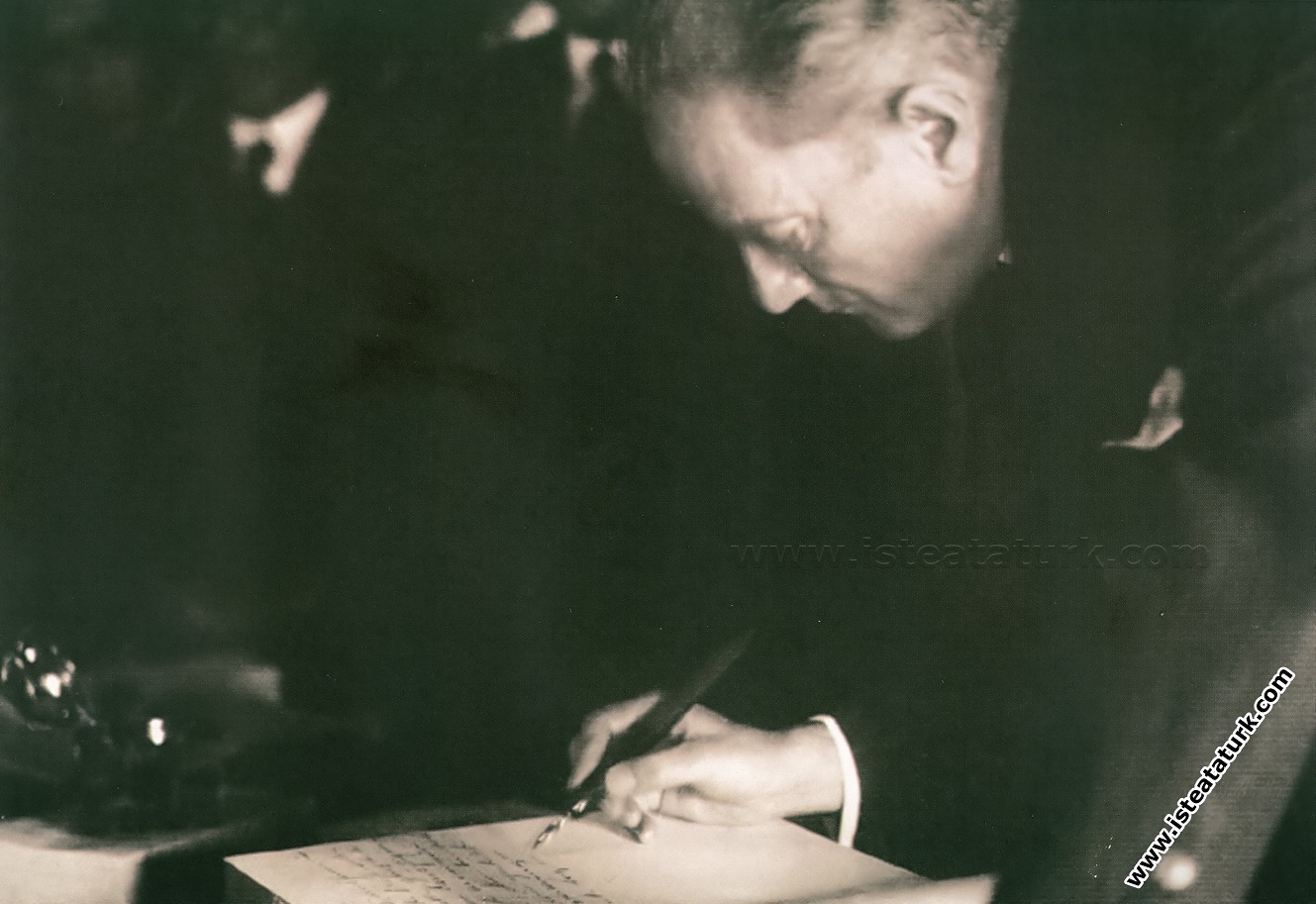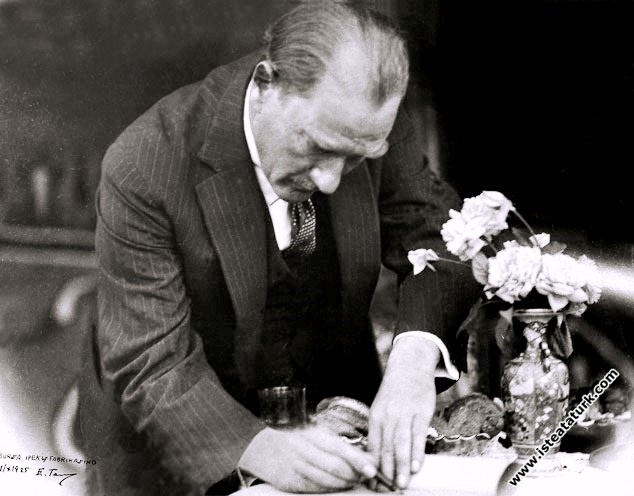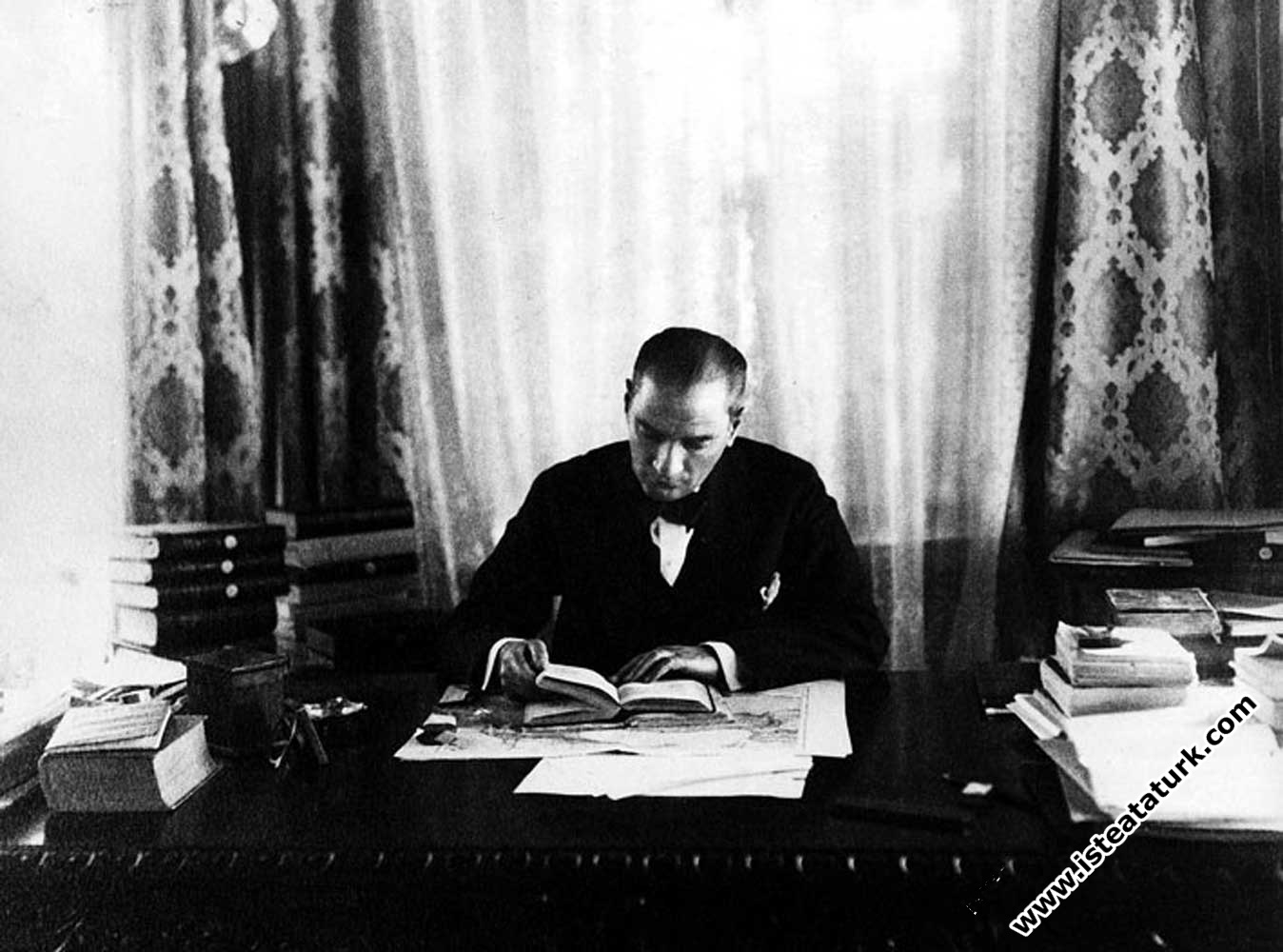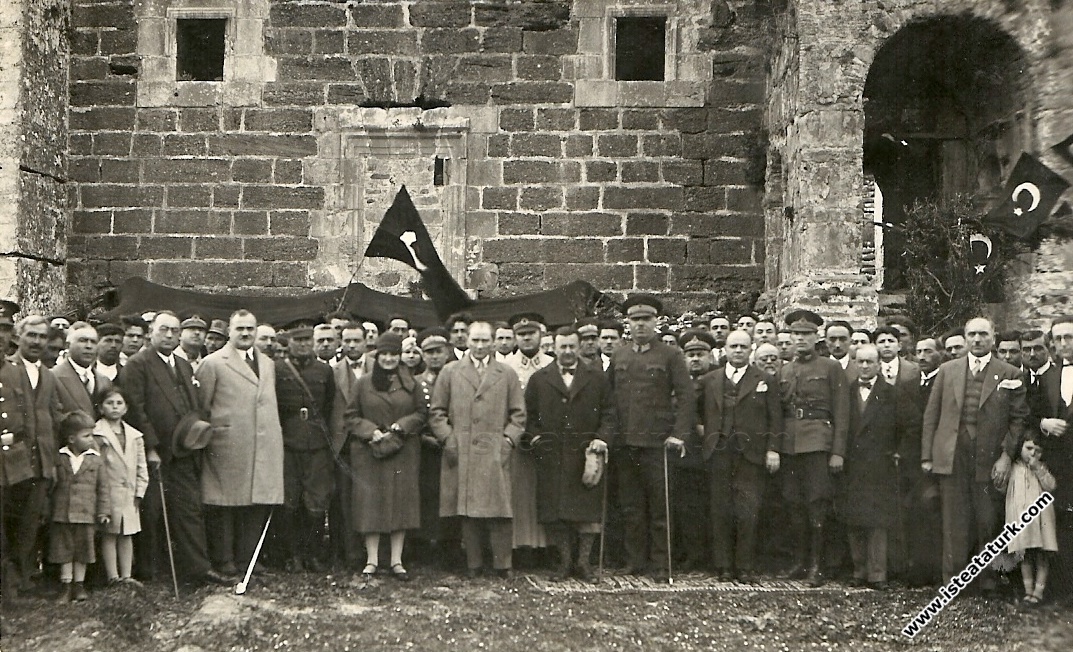
Atatürk and Turkish History
Character Size
“Our ancestors, who established great states, had a great civilization. It is a debt for us to seek, examine, and inform Turkishness and the world." Mustafa Kemal Atatürk
ATATÜRK AND TURKISH HISTORY
When we examine Atatürk's life, we see that he knew the Turkish nation very well in almost all aspects. Namely; Due to his military profession, he got to know his homeland and nation in various aspects on the battlefields, according to his ranks. In addition, his constant reading of historical works from an early age helped him gain extensive knowledge of Turkish history, and as he got to know the Turkish nation, he began to understand what a great nation it was. It is his immense love and trust towards the Turkish nation that, despite the bad conditions, prompted him to unfurl the flag of struggle for the independence of the Turkish nation. According to him, a great and noble nation like the Turks was “better to perish than to live in captivity”. The great Atatürk, who loved the Turkish nation and could not tolerate any of its rights being taken away from him,
Atatürk, who read a lot and had a good knowledge of history, was a person who knew the unfair opinions of the Western world about Turks at that time. Atatürk, who witnessed that the Christian Western world, which could not forgive the Turks, whom they claimed did not have a rich culture and great civilization, ruled half of Europe for centuries, wanted to expel the Turks not only from Europe, but also from Anatolia, was able to stop this attack. Since the first years of the National Struggle, Atatürk opposed such unfair attitudes and said that Turkish history is adorned with great civilization and rich culture, and that this will be revealed when the time comes. Finally, after the great victory was won, after the re-establishment of the Turkish state and showing the whole world that Anatolia will forever remain the Turkish homeland, Atatürk said:
We see that Atatürk's directives for a short time research on Turkish history are for the following two purposes:
a) Turkish history will be well researched from the beginning, and the contributions of Turks to the world of culture and civilization and the services of the great personalities they raised to humanity will be revealed. Thus, the world would learn what an honorable past and rich culture the Turks had, and the newly-grown Turkish children would be aware of the glorious history of their ancestors and would brag about them. At the same time, this would strengthen the national unity and enthusiasm of the Turkish nation, and would be a great support for the Turks in overcoming difficulties and reaching the level of contemporary civilization, as it was during the years of the National Struggle.
b) The second goal of Atatürk was to investigate the ancient history of Anatolia, which Westerners see as a homeland for us. Atatürk thought that maybe the Turks might have come to Anatolia before the 1071 Malazgirt victory. If it is determined that there were Turks among the tribes who came from Asia and established civilizations in Anatolia in the first ages of history, it will be possible to refute the claim of a Western society that “Turks are a nation that came to Anatolia later, they should return to where they came from”.
So how did this happen? We see that Atatürk accelerated the efforts that he started during the years of the War of Independence in order to realize this issue, after the proclamation of the Republic. He tried to develop it in two stages. The first of these was education, and the second was the Turkish Hearths. In the speech he made on March 1, 1922, when the War of Independence was still going on, at the opening of the 3rd Meeting of the First Term of the Grand National Assembly of Turkey, the first goal of Turkish National Education was to teach individuals their homeland, nation, religion, customs and traditions. He said that his second goal was to teach the customs and history of Turkey, and stated that his second goal is to teach our children and young people, who will grow up, first and foremost the elements that are hostile to Turkey's independence, its own identity and national traditions, regardless of the boundaries of their education. (Atatürk's Discourses and Statements, Istanbul, 1945, F, a. 224) In the directive he gave to teachers and faculty members on October 27, 1922, Atatürk said: “Our only guide in the political and social life of our nation, in the intellectual education of our nation, will be science and science. ... We will follow the same path of science and science as our schools and darülfünuns, which are essential for raising our nation.” (Atatürk's Discourses and Statements, II, pp. 42-45)
Atatürk not only loved Turkish history, but also showed a close interest in those who work on this issue. As a matter of fact, the Great Leader, after reading the History of Turkey published by Fuat Köprülü in 1923, sent the following letter to its author:
“To Köprülüzâde Mehmet Fuat Bey, the Professor of the History of Turkish Literature of the Darülfünun,
I have read the first book of your History of Turkey that has been sent, with great pleasure and benefit. The work is valuable and important. I appreciate the effort you put into bringing this into existence. The works of your specialization will be found in the most valuable level of the services that can be performed to the nation and the republic.
I hope that your follow-up books will be published together with those who are intrigued by the enlightenment, sir.
President of Turkey
Gazi Mustafa Kemal”
Atatürk, who believes that the national excitement will only be strengthened and continued with the consciousness of national history and national culture, has given great importance to national history researches. Because he was a person who knew very well what a great mistake it is for a nation to see national history with the eyes of foreigners, or rather to understand it as they show. He attached great importance to the development of historical research in this country in order to bring his nation, which he had achieved economic and political independence, to spiritual independence.
Seeing that the destiny of the Turkish Nation is closely tied to Europe, the cradle of Western civilization, Atatürk believed that the Turkish Nation must protect and strengthen its national culture before entering the world of Western civilization. If, along with the Western civilization, the cultures of the nations that created this civilization enter Turkey and take Turkish culture under its influence, then it is perfectly clear that the political independence gained with great sacrifices will not work, because the nations that lose their culture will sooner or later lose their political independence. he knew. He wanted the education and training to be given to the new generations as follows:
I am of the opinion that the education and training methods followed so far are the most important factor in the history of our nation. That's why, when I talk about a national education program, I mean a culture that is compatible with our history and nationality, completely free from the superstitions of the old age and foreign ideas that have nothing to do with our nature, and all the influences that may come from the East and the West. Because the genius and the complete development of our nation can only be achieved through such a culture. Culture is relative to the ground. That ground is the level of the nation.” (Atatürk's Discourses and Statements, II, 16-17).
With the following speech of Atatürk in 1929, we witness a different expression of what the Turkish Nation is and how its history has followed:
“Every person of the Turkish Nation is similar to each other in general but with some differences. Of course, it is necessary to find some differences in construction. Because... is it possible for all the children of today's children of such an old and such a large human society, which lived and fused for thousands of years under the influence of other climates, to other natives, resemble each other? It is not always the case that even the children of a small family are completely alike. It is not correct to think that the Turkish people appeared only at one point, in a narrow zone with a climate…” (Atatürkçülük, p. 7-8).
Atatürk says the following about the homeland of Turks:
“The Turkish Nation lives in a large, world-renowned homeland in the west of Asia and in the east of Europe, distinguished by land and sea borders. They call him 'Turkish'. The Turkish homeland is much bigger. Considering the near and far times, there is no continent that has not settled in the Turks. All over the world, Asia, Europe and Africa have been home to Turkish ancestors. These truths are known by old and especially new historical documents. But today's Turkish Nation is content with its present homeland for its existence. Because the Turk is sure that the deep and glorious past will preserve the sacred heritage of his mighty ancestors in this homeland, and that he will enrich those heritages much more than it has until now…” (Atatürk, General Staff Military History and Strategic Studies Presidency Publications, Ankara, 1980, p. pp. 537-538).
Finally, thinking that the time he desired for the research activities of Turkish history has come and the ground has been formed, Atatürk took action and gathered on April 23, 1930, Türk Ocakları VI. He took the necessary step in the Congress. With the directive he gave, the delegates of the Congress added the article “It constitutes a “Turkish History Committee” to be responsible for the scientific study of Turkish History and Civilization and to act on it” to the Turkish Hearths Law. (A. Afet Inan, Memories of Ataturk While Commemorating Kemal Ataturk 2 Ankara, 1955, p. 81)
Atatürk gave directions to Afet Hanım and Mehmet Tevfik, Hasan Cemil, Sadri Maksudi, Şemseddin, Vâsıf and Yusuf Ziya, members of the Turkish History Committee, and asked them to produce a work called “The Main Lines of Turkish History” through copyright and translation in a short time. After hard work, the members of the delegation produced a work of six hundred pages, and this work was printed in the state printing house. After the name and authors were written on the cover of the book, the following addition was made in small letters: “Only one hundred copies were printed in order to be presented to the opinions and criticisms of other members of the Turkish History Committee and persons related to the subject.” (Outlines of Turkish History, Istanbul 1930)
After these experiences in teaching and researching Turkish history, Atatürk declared the establishment of the “Turkish History Research Society” as an independent scientific institution on April 15, 1931. After a while, the “Turkish Historical Research Society”, the Turkish Historical Society, and the Turkish Hearths were replaced by the Community Centers. (A. Afet Inan, “On the Establishment of the Turkish Historical Society”, Belleten, Vol. XI, No: 42 (1947), p. 179).
Immediately after this change, Atatürk asked our historians gathered around the Turkish History Society to reveal the following issues through scientific methods:
“The Turks as a tribe cannot establish an empire in Anatolia. There must be another explanation for this. The science of history should reveal this... I wonder if it should be revealed with the lost and lived ancient civilization of the Mediterranean. Who are the autochthonous people and the people that make up the civilization in various parts of the world, especially in Turkey? What is the role of the Turks in the history of the world and in the realm of civilization? (A. Afet Inan “Ataturk and the History Thesis” Belleten, C. III, Issue 10 (1939), pp. 244-245).
In order to clarify these questions of Atatürk, he held his congress with Turkish historians in July 1931. Before starting his work, he told the members of the congress, “Our nation has a deep past. Of course, this thought will lead us to the Seljuk Turks, from the six-seven-hundred-year-old Ottoman Turkishness, and before that to the Turkish states that were equal to each of these periods” (A. Taneri, “The Idea Man Atatürk and the Republic”, Tercüman, 10. XI, 1983 , p. 2) and “Our ancestors who established great states and had a great comprehensive civilization. It is our duty to seek, examine, and inform Turkishness and the world," said Atatürk, who made them work more enthusiastically. (Afet Inan, Ataturk's History Thesis, p. 245)
Finally, the congress completed its exhausting and exciting work and found the necessary answers to the questions Atatürk wanted to be clarified above, and presented them to the great leader. These studies, which will be known as Atatürk's Turkish History Thesis, can be summarized as follows. “The cultural homeland of the Turkish race is Central Asia, which has had a high agricultural life since the early ages, and spread from Central Asia to the east and south, and to the north and south of the Caspian Sea in the west. These people, who brought their culture to the places they went, also mingled with the local people in the places they settled. They are the representatives of the Central Asian brachycephalic race that founded and developed the Iraqi, Anatolian, Egyptian and Aegean civilizations. Since Turks are of the same race, it is most likely that the people who founded these civilizations (especially the Hittites and Sumerians) could be our ancestors” (Afet Inan, Ataturk's History Thesis, p.
By giving instructions to Turkish historians, the issues covered in the four-volume teaching to be taught in schools, including the above ideas, did not go beyond the history and civilization of the Ottomans and Seljuks. However, it is obvious that the Turks, who founded and ruled the Seljuk and Ottoman Empires, two of the world's largest empires in the Islamic era, had to have the same tradition of establishing and administering a state before Islam. He wanted Turkish children to learn about the pre-Islamic Turkish history, especially in the Islamic era, "how unique aptitude the Turkish nation had in the military, administration, politics as well as in science, science, literature, arts such as painting, music, architecture, and sculpture". . (History, Istanbul, 1934, IV, pp. 259-260)
While these feverish studies on Turkish history were going on, Atatürk frequently warned our historians that they should "penetrate the events thoroughly, evaluate all the evidence for and against, and adopt an impartial interpretation as a principle". Reminding that the wrong opinions and prejudices about us can be corrected through scientific and objective research based on such documents, Atatürk's last advice to historians was: “First of all, rely on the documents that you will choose carefully and carefully. Before anything and everyone, use your own initiative and national filter in the examinations you will make on these documents.” (M. İlgürel, “Atatürk and Ottoman History”, Paper given at the Turcology Congress in September 1973, p. 6)
There is almost no difference between the History method used in scientific history research today and the directives Atatürk gave to Turkish historians above. In addition, Atatürk had some of his method books translated from foreign languages into Turkish so that there would be no methodlessness in historiography and made them available to historians. CH Longlois and Ch Seignobos' "Introduction to Historical Studies" and E. Bernheim's "Introduction to History, Method and Philosophy of History" were published in 1936 and 1937. Despite this, the content of history, which was taught in school books as Atatürk's Turkish History Thesis, could not escape criticism. Why were these criticisms made? Which points of the Turkish History Thesis have been objected or criticized? These and similar questions must be addressed sincerely. Only then will it be possible to tell the truth and what the great Atatürk wanted to do. At the beginning of the issues criticized internally and externally about Atatürk's History Thesis is why the Scythians, Hittites and Sumerians were dealt with while the Turkish history before the Ottoman and Seljuk periods, especially the Hun, Uyghur and Gokturk periods. This point of view, which has been criticized in Europe and in some local circles, is based on very fundamental reasons:
1- Atatürk created a revolution. This is a "Reuslution" that occurred against the world view of the Ottoman Empire in the last centuries. In this respect, he could not set an example of Ottoman History for the nation he wanted to equip with a new spirit.
2- At the same time, Atatürk put forward the new history thesis to use it as a moral defense weapon against the invaders. After the first great war, the forces that wanted to invade the Turkish homeland acted by putting forward some historical reasons. Those who told the Greeks, who once established a great civilization in Western Anatolia, "This land is yours," and prompted them to invade, wanted to use history as a tool for imperialist ideas.
While researching Turkish history, one of the things Atatürk desired was to reveal the contributions of Turks to world culture. The II History Congress convened in September 1937 helped to get the first information on this issue.
Sevcihan Özer
Source: ATATÜRK ARAŞTIRMA MERKEZİ DERGİSİ, Sayı 44, Cilt: XV, Temmuz 1999
